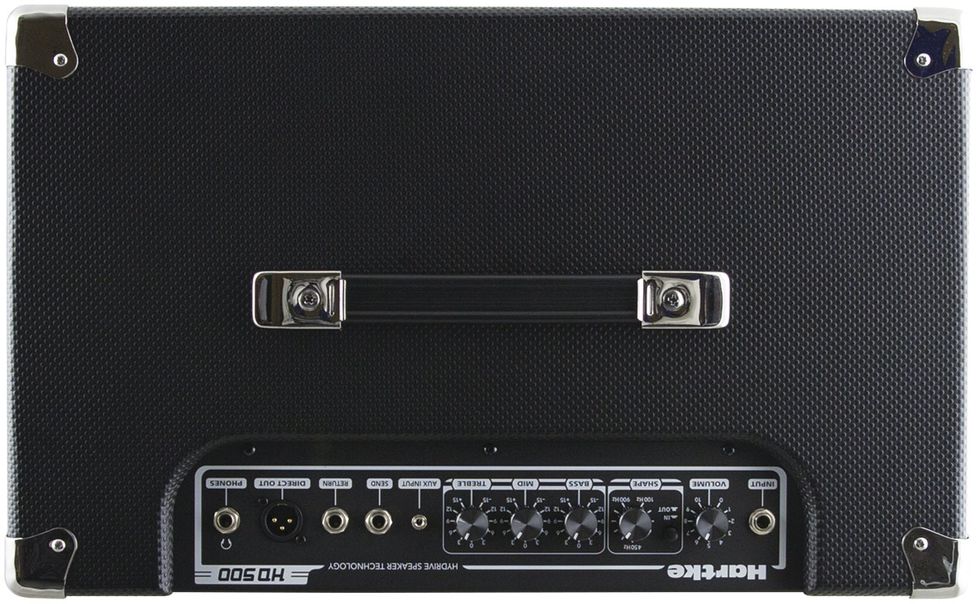Recorded direct into Focusrite Saffire 6 interface into MacBook Pro using GarageBand.
Clip 1 - Fender American Elite PJ with bridge pickup soloed: Bass flat, mid at 1 o'clock, treble at 9 o'clock.
Clip 2 - Fender American Standard Jazz: Flat EQ.
RatingsPros:Portable, powerful combo. Cons: Slightly squashed sound. Street: $599 street Hartke HD500 samsontech.com | Tones: Ease of Use: Build/Design: Value: |
You don’t have to be a bass geek to know about Hartke’s reputation. The company’s amplification—renowned for its integration of aluminum into speaker design—has been pleasing the ears of many players and listeners for over 30 years. Weekend warriors all the way to low-end legends such as Jack Bruce and Victor Wooten have relied on the company’s wares to deliver tonal flexibility and robust power. Of late, Hartke’s designs have evolved to mesh their signature sound with more portable packages. The HD500 is one of their most recent. It’s a stout combo that pairs a 500-watt amp with proprietary speakers and tips the scales a tick under 35 pounds.
Aluminum Alchemy
The HD500 houses a pair of 10" HyDrive speakers. Interestingly, it was the aforementioned Cream bassist who inspired Hartke’s HyDrive speaker technology. Mr. Bruce’s use of both the company’s aluminum- and paper-speaker cabinets onstage was what led Hartke to consider fusing the two materials into one driver. As a result, they were able to combine the warmth of traditional paper cones with the attack and clarity of aluminum. Furthering the contemporary speaker design is the use of neodymium magnets, which are intended to deliver significant weight reduction without sacrificing performance.
A 500-watt, class-D amplifier pushes the drivers and offers streamlined tone shaping on its control panel. The proprietary Shape section is seated to the left of the bass, mid, and treble controls. It consists of a pushbutton switch to activate the feature and a control knob to customize the effect of the Shape curve. This notch filter allows a player to cut 20 dB from a chosen frequency. It moves clockwise for the higher frequencies and counterclockwise for the lower ones.
Hartke included other quite practical components in the HD500’s feature set. The aux input allows connecting a media player for play-along capability. There are 1/4" unbalanced send and return jacks to use with outboard effects processors. And next to the DI is a handy headphones jack. When headphones are connected, the speaker output is disabled and the HD500 is transformed into a silent practice amp.
HY Life
My time with the HD500 began with it going straight from the delivery truck to the trunk of my car, and then to a country/rock show in downtown Nashville. A busy night in the city resulted in a typical lack of parking options, so I had to schlep the rig about a quarter-mile to the venue. Fortunately, the weight and design of the HD500 made it easy to transport as I navigated the densely populated sidewalks and the stairs leading up to the third-floor club.
Soundcheck allowed me to experiment with the combo’s features prior to the show. With both a Fender Elite Precision (with a P/J setup) and an NS Design NXT electric upright with me that night, I started with the HD500’s controls set flat and turned off the shape section. Hartke’s latest produced big low end, slightly scooped upper mids, and clean highs. The HD500’s EQ was voiced to accommodate my tastes, whether I was dialing back the bass knob to temper the beefy upright or slightly boosting the mid control to bring out the sonic details of my P. When engaged, the Shape section was useful in removing the strong midrange of the EUB, as it immediately alleviated any honk and clacking sounds with a turn of the frequency knob. That said, the Shape’s 20 dB filter took out just a bit too much for my taste.

Power was never an issue with the HD500. Regardless of the support from the house PA, the combo held its own while seated between a pair of 50-watt guitar amps and a heavy-hitting drummer. The rig was fairly unflappable even at extreme volumes, and I never felt like it was being pushed too hard throughout the four-hour set.
Yes, the HD500 was pleasing in both the features and performance departments, but my impressions of the tone were a touch mixed. The combo delivered notes with immediacy, but the sound would occasionally get squashed when I’d accent notes or play at higher volumes. It should be noted that I’m not an over-the-top aggressive player, but I do occasionally dig in when the music requires it. On a positive note, the HD500 will likely delight slappers, since the combo gave thumb work and string popping impressive punch and transient attack—ideal during an impromptu performance of the Red Hot Chili Peppers’ take on “Higher Ground.”
The Verdict
In a market flooded with lightweight options, what makes the HD500 stand out? Hartke’s combo contains a lot of power, no-nonsense features, and a price tag that won’t deplete your tax return. Its tone might feel overly compressed at times, to some ears, but it projects bass notes with quick response and focus. If you’re an on-the-go bassist looking for a convenient combo amp, do your wallet, back, and bass a favor by taking a look at the HD500.
Watch the Review Demo:








![Rig Rundown: AFI [2025]](https://www.premierguitar.com/media-library/youtube.jpg?id=62064741&width=1245&height=700&quality=70&coordinates=0%2C0%2C0%2C0)












 Shop Scott's Rig
Shop Scott's Rig


![Rig Rundown: Russian Circles’ Mike Sullivan [2025]](https://www.premierguitar.com/media-library/youtube.jpg?id=62303631&width=1245&height=700&quality=70&coordinates=0%2C0%2C0%2C0)












































